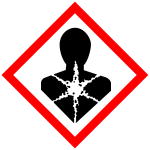Notified classification and labelling according to CLP criteria
General Section
EC / List no.

|
Name |
CAS Number

|
Additional Notified Information

|
|---|---|---|---|
| 946-528-3 | Polyurethane prepolymer based on Diphenylmethane-Diisocyanate. |
State/Form
|
| Classification | Labelling | Specific Concentration limits, M-Factors | Notes |
Classification affected by Impurities / Additives

|
||
|---|---|---|---|---|---|---|
| Hazard Class and Category Code(s) | Hazard Statement Code(s) | Hazard Statement Code(s) | Supplementary Hazard Statement Code(s) | |||
| Skin Irrit. 2 | H315 | H315 | ||||
| Skin Sens. 1 | H317 | H317 | ||||
| Eye Irrit. 2 | H319 | H319 | ||||
| Acute Tox. 4 | H332 | H332 | ||||
| Resp. Sens. 1 | H334 | H334 | ||||
| STOT SE 3 | H335 (other:respirato...) (inhalation) | H335 | ||||
| Carc. 2 | H351 | H351 | ||||
| STOT RE 2 | H373 (other:respirato...) (inhalation) | H373 (May cause damag...) | ||||
| Signal Words | Pictograms | ||||||
|---|---|---|---|---|---|---|---|
| Danger |
|
Detailed Information on classification and labelling
Classification
| Physical and Chemical hazards | |||
|---|---|---|---|
| Hazard Category | Hazard Statement |
Reason for no Classification

|
|
| Explosives | data lacking | ||
| Flammable Gases and Chemically Unstable Gases | data lacking | ||
| Flammable Aerosols | data lacking | ||
| Oxidising Gases | data lacking | ||
| Gases Under Pressure | data lacking | ||
| Flammable Liquids | data lacking | ||
| Flammable Solids | data lacking | ||
| Self-reactive Substances and Mixtures | data lacking | ||
| Pyrophoric Liquids | data lacking | ||
| Pyrophoric Solids | data lacking | ||
| Self-heating Substances and Mixtures | data lacking | ||
| Substances and Mixtures which in contact with water emit flammable gases | data lacking | ||
| Oxidising Liquids | data lacking | ||
| Oxidising Solids | data lacking | ||
| Organic Peroxides | data lacking | ||
| Substances and Mixtures corrosive to Metals | data lacking | ||
| Desensitized Explosives | data lacking | ||
| Human Health hazards | |||
| Hazard Category | Hazard Statement |
Reason for no Classification

|
|
| Acute Toxicity - Oral | data lacking | ||
| Acute Toxicity - Dermal | data lacking | ||
| Acute Toxicity - Inhalation | Acute Tox. 4 | H332 | |
| Skin Corrosion / Irritation | Skin Irrit. 2 | H315 | |
| Serious Eye Damage / Eye Irritation | Eye Irrit. 2 | H319 | |
| Respiratory Sensitisation | Resp. Sens. 1 | H334 | |
| Skin Sensitisation | Skin Sens. 1 | H317 | |
| Aspiration Hazard | data lacking | ||
| Germ Cell Mutagenicity | Hazard Category | Hazard Statement |
Reason for no Classification

|
| Germ Cell Mutagenicity | data lacking | ||
| Carcinogenicity | Hazard Category | Hazard Statement |
Reason for no Classification

|
| Carcinogenicity | Carc. 2 | H351 | |
| Reproductive Toxicity | Hazard Category | Hazard Statement |
Reason for no Classification

|
| Reproductive Toxicity | data lacking | ||
| Effects on or via Lactation | data lacking | ||
| Specific target organ toxicity - Single | Hazard Category | Hazard Statement |
Reason for no Classification

|
| Specific target organ toxicity - Single | STOT SE 3 | H335 | |
| Affected Organs | other:respiratory system | ||
| Route of exposure | inhalation | ||
| Specific target organ toxicity - Repeated | Hazard Category | Hazard Statement |
Reason for no Classification

|
| Specific target organ toxicity - Repeated | STOT RE 2 | H373 | |
| Affected Organs | other:respiratory system | ||
| Route of exposure | inhalation | ||
| Environmental Hazards | |||
| Hazardous to the aquatic environment | Hazard Category | Hazard Statement |
Reason for no Classification

|
| Hazardous to the aquatic environment - acute | data lacking | ||
| Hazardous to the aquatic environment - chronic | data lacking | ||
| Hazardous to the atmospheric environment | Hazard Category | Hazard Statement |
Reason for no Classification

|
| Hazardous to the ozone layer | data lacking | ||
| Additional Hazard Classes | Additional Hazard Statements |
|---|---|
| No available Data | |
Labelling
| Hazard Statement Code(s) | Phrase | Additional Text |
|---|---|---|
| H315 | Causes skin irritation. | |
| H319 | Causes serious eye irritation. | |
| H317 | May cause an allergic skin reaction. | |
| H332 | Harmful if inhaled. | |
| H335 | May cause respiratory irritation. | |
| H334 | May cause allergy or asthma symptoms or breathing difficulties if inhaled. | |
| H351 | Suspected of causing cancer |
|
| H373 | May cause damage to organs |
May cause damage to respiratory system through prolonged or repeated exposure by inhalation |
| Note Title | Note Text |
|---|---|
| No available Data | |

